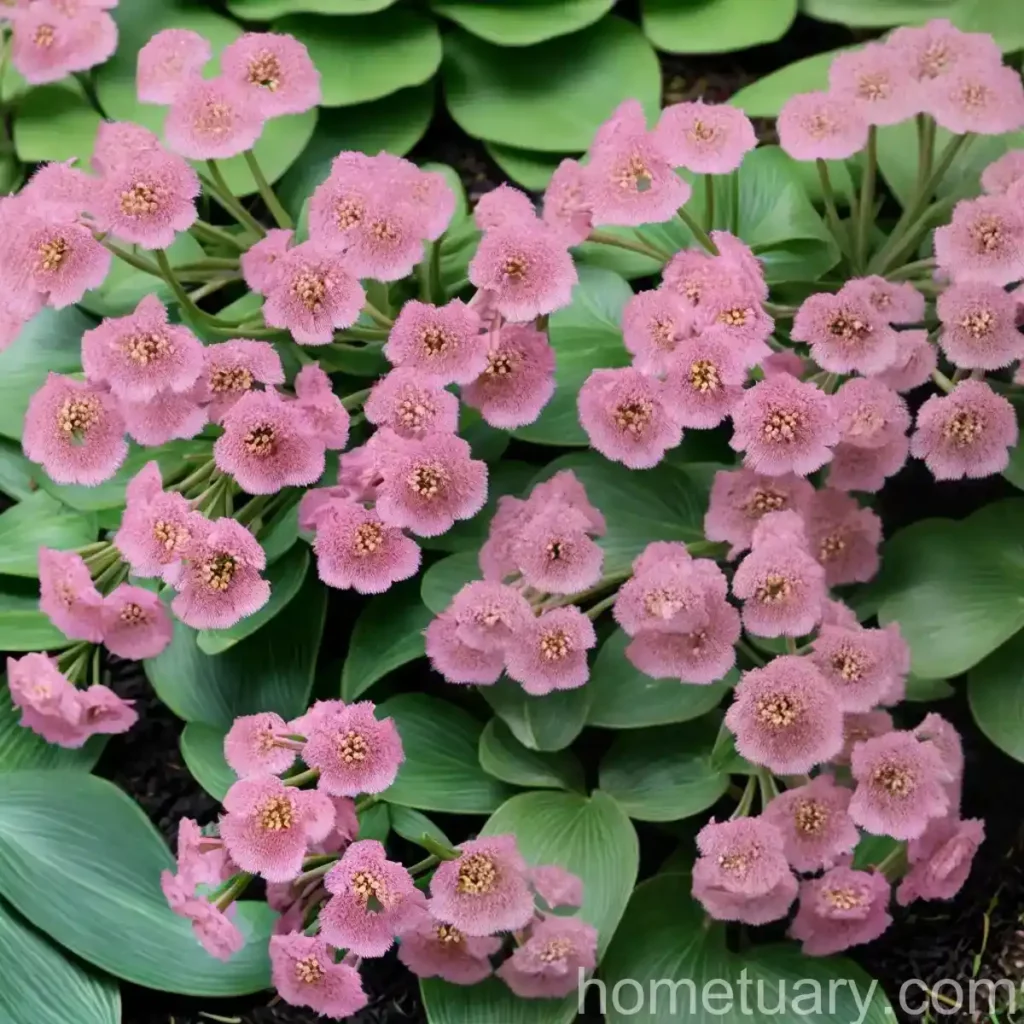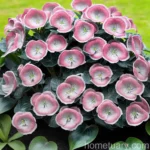Pigsqueak (Bergenia cordifolia): A Beautiful and Versatile Plant for Your Garden

Pigsqueak, scientifically known as Bergenia cordifolia, is an enchanting perennial plant that has captured the hearts of gardeners for centuries. Its unique nickname, “pigsqueak,” comes from the sound produced when rubbing a leaf between one’s fingers. Native to Central and North Asia, pigsqueak is a resilient and low-maintenance plant that adds charm and elegance to any garden landscape. In this comprehensive guide, we will delve into the world of pigsqueak, exploring its cultivation, uses, care tips, and much more.
What is Pigsqueak (Bergenia cordifolia)?
Pigsqueak, or Bergenia cordifolia, is a herbaceous perennial plant belonging to the Saxifragaceae family. This enchanting plant is characterized by its large, leathery, and shiny leaves. In spring, pigsqueak produces clusters of dainty flowers that rise above the foliage, creating a breathtaking display. The vibrant blooms come in various shades, including pink, magenta, and white, offering a splash of color to the garden.
The foliage of pigsqueak is semi-evergreen, maintaining its beauty throughout the year. As it grows, pigsqueak forms dense clumps, making it an ideal choice for ground cover or border plantings. Due to its adaptability to different conditions and minimal upkeep requirements, pigsqueak has become a favorite among gardeners seeking a resilient and aesthetically pleasing addition to their landscapes.
Key Takeaways – Pigsqueak (Bergenia cordifolia)
Culture
- Scientific Name: Bergenia cordifolia
- Common Name: Pigsqueak
- Family: Saxifragaceae
- Type: Herbaceous perennial
Uses
- Landscape Design: Ground cover, borders, rock gardens, erosion control, mixed borders, urban gardens
- Other Uses: Cut flower arrangements, herbal medicine
Water
- Watering Requirements: Moderate
- Watering Frequency: Regular watering, especially during prolonged dry spells
- Soil Moisture: Well-draining soil
Sunlight
- Sunlight Needs: Partial to full shade
- Tolerance: Tolerates shade well, particularly in hot climates
Fertilizer
- Fertilization: Minimal fertilization required
- Fertilizer Type: Balanced, slow-release fertilizer in spring
Soil
- Soil Preferences: Moist, well-draining soil
- Soil pH: Neutral to slightly acidic
Pruning
- Pruning Requirements: Low
- Pruning Time: Remove faded flowers, trim back damaged or untidy leaves
Propagation
- Propagation Methods: Division, seed propagation
- Best Time for Division: Early spring
Container Popularity
- Suitability: Well-suited for container planting
- Container Types: Pots, planters, containers with well-draining soil
Common Diseases
- Susceptibility: Generally disease resistant
- Common Issues: Rot in waterlogged conditions
Disease Diagnosis
- Symptoms: Dark, mushy foliage, foul odor
- Preventive Measures: Ensure proper drainage, avoid overwatering
Common Pests
- Pest Issues: Relatively pest-free
- Potential Pests: Aphids, slugs, snails
- Control Measures: Natural predators, hand-picking, organic repellents
Botanist’s Tips
- Adaptability: Resilient in various conditions
- Year-Round Interest: Semi-evergreen foliage for year-long appeal
- Versatility: Suitable for different landscape designs and gardening styles
Fun Facts
- Nicknames: Pigsqueak, elephant’s ears
- Historical Use: Herbal remedy for various ailments
- Native Habitat: Central and North Asia
Now that we have gathered a comprehensive overview of pigsqueak, let’s dive deeper into its care, cultivation, and the myriad ways it can be incorporated into your garden landscape.
Pigsqueak Plant Care
The successful cultivation of pigsqueak (Bergenia cordifolia) is attributed to its adaptability and minimal care requirements. Whether you are a seasoned gardener or a novice enthusiast, pigsqueak can thrive in various conditions, making it an excellent choice for gardens of all types. Let’s explore the essential care tips for growing and maintaining this charming plant.
Water Requirements
Pigsqueak requires moderate watering, particularly during the growing season. While it can tolerate short periods of drought, consistent moisture is essential for optimal growth and flowering. Here are some key points to consider for effectively managing water requirements:
- Watering Frequency: Provide regular watering, ensuring the soil remains evenly moist but not waterlogged.
- Established Plants: Once established, pigsqueak exhibits good drought tolerance. However, ensure it receives sufficient moisture during prolonged dry spells.
- Avoid Overwatering: Prevent waterlogging, which can lead to root rot and other issues. Well-draining soil is crucial for maintaining proper soil moisture levels.
Sunlight Needs
Pigsqueak thrives in partial to full shade, making it an ideal choice for shaded areas in the garden. While it can tolerate some sunlight, especially in cooler climates, it generally prefers sheltered locations with limited direct sun exposure. Here are some considerations related to sunlight requirements:
- Partial Shade: Provide dappled or filtered sunlight for best results, particularly in regions with hot summers.
- Shade Tolerance: Pigsqueak exhibits excellent tolerance to shade, making it a versatile option for landscapes with varying light conditions.
Fertilization
Minimal fertilization is required for pigsqueak, as excessive nutrients can lead to lush foliage at the expense of flowering. A balanced, slow-release fertilizer applied in spring can provide the necessary nutrients for healthy growth and bloom production.
- Fertilizer Type: Use a balanced, slow-release fertilizer to avoid excessive vegetative growth.
- Frequency: Apply fertilizer once a year in early spring to support the plant’s growth and flowering.
Soil Preferences
Pigsqueak thrives in moist, well-draining soil with a slightly acidic to neutral pH. Amending the soil with organic matter can further enhance its quality, promoting optimal growth and overall health.
- Soil Moisture: Ensure the soil remains consistently moist, but not waterlogged, to support vigorous growth and flowering.
- Soil Quality: Incorporate organic matter such as compost or peat moss to improve soil structure and fertility.
Pruning
Pruning requirements for pigsqueak are minimal and primarily focused on removing faded flowers and trimming back any damaged or untidy foliage. By conducting regular maintenance, you can promote a tidy appearance and encourage the plant’s overall vigor.
- Pruning Time: Trim back faded flower stalks and any damaged or discolored leaves as needed.
- Faded Flowers: Removing spent blooms can promote continuous flowering and prevent self-seeding in the garden.
Propagation
Pigsqueak can be propagated through division and seed propagation. Early spring is the best time for division, providing ample opportunity for the newly divided plants to establish themselves before the onset of summer.
- Division: Carefully divide the plant, ensuring that each division has sufficient roots and foliage for successful growth.
- Seed Propagation: Collecting and sowing seeds can also be a rewarding propagation method, offering an opportunity to grow new plants from scratch.
Container Popularity
The adaptability and ornamental appeal of pigsqueak make it a popular choice for container planting. Whether placed on patios, balconies, or as focal points in the garden, the versatility of container-grown pigsqueak opens up a myriad of design possibilities.
- Container Types: Choose pots, planters, or containers with ample drainage holes to ensure proper soil moisture levels.
- Well-Draining Soil: Utilize well-draining potting mix to maintain optimal soil conditions within the container.
With these essential care tips in mind, you can confidently cultivate and nurture pigsqueak (Bergenia cordifolia) in your garden, creating a stunning display of foliage and vibrant blooms.
Pigsqueak (Bergenia cordifolia) Varieties
The diverse range of Bergenia cordifolia varieties offers an array of leaf colors, flower forms, and growth habits, allowing gardeners to select the most suitable option for their specific landscape needs. From striking foliage variations to unique bloom colors, the following are some notable pigsqueak varieties that have captivated the gardening community:
| Variety | Key Features |
|---|---|
| ‘Winterglut’ | Deep rose-pink flowers |
| ‘Bressingham White’ | White to pale pink blooms |
| ‘Eroica’ | Dark pink flowers, red-tinged leaves |
| ‘Abendglut’ | Rich raspberry-pink flowers |
| ‘Flore Pleno’ | Double pink flowers |
| ‘Rosi Klose’ | Rosy-pink blooms, bronze-red foliage |
Each of these varieties presents unique characteristics that contribute to the allure and versatility of pigsqueak in garden landscapes. By incorporating different varieties, gardeners can create visually captivating displays and enhance the overall aesthetic appeal of their outdoor spaces.
Growing Pigsqueak Flowers
Cultivating pigsqueak flowers involves providing the ideal growing conditions to support lush foliage and abundant blooms. Whether planted as a ground cover, border accent, or container specimen, the following considerations are vital for successful pigsqueak flower production:
- Optimal Growing Conditions: Select shaded to partially shaded locations with well-draining, fertile soil for prolific flower development.
- Regular Watering: Maintain consistent soil moisture, especially during dry periods, to encourage robust growth and flowering.
- Pruning and Deadheading: Remove faded flowers and trim back any damaged foliage to promote continuous blooming and maintain plant vigor.
- Variety Selection: Experiment with different Bergenia cordifolia varieties to explore an array of flower colors and forms, adding diversity to the garden landscape.
By adhering to these guidelines, gardeners can nurture healthy and vibrant pigsqueak flowers that contribute to the visual splendor of their outdoor environments.
Pigsqueak Perennial: A Long-Lasting Garden Addition
As a perennial plant, pigsqueak offers the distinct advantage of returning year after year, providing enduring beauty and appeal to garden landscapes. The resilience and long-lasting nature of pigsqueak make it a valuable asset for establishing reliable and visually captivating garden displays.
Pigsqueak Plant Characteristics
The distinctive characteristics of pigsqueak (Bergenia cordifolia) contribute to its desirability and effectiveness as a garden plant. Whether focusing on its foliage, flowers, or overall growth habits, the following key traits showcase the allure and versatility of pigsqueak in various landscape settings:
- Foliage: Large, glossy, leathery leaves with enchanting shades of green, bronze, or red, depending on the variety.
- Flowers: Clusters of dainty, bell-shaped flowers in captivating hues, such as pink, magenta, white, and variations thereof.
- Growth Habit: Dense, clump-forming growth habit, ideal for ground cover, border plantings, and container cultivation.
- Longevity: Perennial nature, offering long-term appeal and consistent performance in the garden.
- Adaptability: Tolerant of different light conditions, soil types, and environmental stressors, showcasing its versatility as a garden plant.
By recognizing and appreciating these plant characteristics, gardeners can make informed decisions regarding the incorporation of pigsqueak into their garden designs, ensuring a harmonious and visually striking outcome.
Benefits of Pigsqueak (Bergenia cordifolia)
The benefits of cultivating pigsqueak extend beyond its aesthetic appeal, encompassing various practical and functional aspects that contribute to its value as a garden plant. From its resilience to its medicinal properties, pigsqueak offers an array of benefits for both gardeners and the environment:
- Low Maintenance: Requires minimal care and attention, making it suitable for low-maintenance garden designs.
- Ground Cover: Forms dense clumps, effectively covering the ground and suppressing weed growth in the garden.
- Erosion Control: Its spreading habit and robust root system make pigsqueak effective for controlling soil erosion on slopes and embankments.
- Medicinal Uses: Historically used in herbal medicine for its purported healing properties, particularly for skin-related ailments.
- Wildlife Support: Attracts pollinators, such as bees and butterflies, contributing to the ecological balance within the garden environment.
By acknowledging the multifaceted benefits of pigsqueak, gardeners can fully appreciate its contribution to their garden landscapes, recognizing its significance beyond its visual allure.
Pigsqueak Plant Propagation
The propagation of pigsqueak (Bergenia cordifolia) provides gardeners with the opportunity to expand their plantings, experiment with different varieties, and share the beauty of this charming plant with others. Whether through division or seed propagation, the following methods offer viable approaches to propagating pigsqueak:
Division
- Best Time: Early spring, as new growth emerges, provides an optimal window for division, allowing the divided plants to establish themselves before the onset of warmer temperatures.
- Process: Carefully lift the plant, ensuring the divisions retain sufficient roots and foliage. Replant the divisions at the appropriate spacing, providing them with adequate moisture and care.
Seed Propagation
- Seed Collection: Gather seeds from mature Bergenia cordifolia plants, ensuring they are fully ripe before collection.
- Sowing: Sow the seeds in a well-prepared seedbed or containers, providing optimal conditions for germination and early growth. Transplant the seedlings once they have developed sufficient size and vigor.
By propagating pigsqueak through these methods, gardeners can not only expand their plant collections but also perpetuate the captivating beauty of this delightful perennial in their garden and beyond.
Pigsqueak Plant Pruning Tips
Pruning is a fundamental aspect of pigsqueak (Bergenia cordifolia) maintenance, allowing gardeners to enhance the plant’s aesthetics, encourage continuous flowering, and uphold its overall health. Incorporating the following pruning tips can assist gardeners in effectively managing and shaping their pigsqueak plants:
- Faded Flowers: Promptly remove faded flower stalks to prevent the plant from directing its energy into seed production, thereby promoting prolonged flowering.
- Damaged Leaves: Prune back any damaged, discolored, or unsightly foliage to maintain a neat and tidy appearance, while also fostering new growth.
By adhering to these pruning practices, gardeners can ensure the proper care and maintenance of their pigsqueak plants, resulting in a well-groomed and flourishing display within their garden landscapes.
Pigsqueak Plant Uses
The myriad uses of pigsqueak (Bergenia cordifolia) extend beyond its ornamental appeal, encompassing practical applications and diverse garden design possibilities that cater to the varying needs and preferences of gardeners. From medicinal properties to its role in urban gardens, pigsqueak presents a wide range of utilitarian and aesthetic uses:
- Ground Cover: Creates dense mats of foliage, effectively covering the ground and suppressing weed growth.
- Borders and Edging: Provides an attractive border plant, delineating garden beds and pathways with its lush clumps of foliage.
- Container Gardening: Thrives in containers, offering versatility and ornamental value for patio and balcony gardening.
- Medicinal Purposes: Historically used in herbal medicine for its purported healing properties, particularly in traditional remedies for skin-related ailments.
- Wildlife Attraction: Attracts pollinators, contributing to the ecological balance and biodiversity within the garden environment.
- Ornamental Value: Adds visual charm and year-round interest to the garden, enriching the overall aesthetic appeal of the landscape.
These diverse uses highlight the versatility and appeal of pigsqueak as an indispensable component in garden landscapes, showcasing its intrinsic value beyond its visual allure.
Pigsqueak Plant Diseases
Pigsqueak (Bergenia cordifolia) is relatively resilient to diseases, displaying good overall health and vigor under proper growing conditions. However, certain issues, particularly those linked to environmental stressors or improper care, may arise. By recognizing potential disease issues and taking preventative measures, gardeners can safeguard the well-being of their pigsqueak plants.
Disease Resistance
- Overall Resilience: Bergenia cordifolia is generally resistant to diseases when provided with suitable growing conditions, including adequate moisture, drainage, and air circulation.
- Common Issues: The most prevalent disease concern is root and crown rot, which can occur in waterlogged or poorly drained soil conditions.
Disease Diagnosis
- Symptoms: Dark, mushy foliage, foul odor, and wilting are indicative of root and crown rot.
- Preventive Measures: Ensure proper soil drainage and avoid overwatering to mitigate the risk of disease development.
By promptly addressing potential disease issues and maintaining optimal growing conditions, gardeners can foster the robust health and vitality of their pigsqueak plants, preventing the onset of detrimental diseases.
Pigsqueak Plant Pests
Pigsqueak (Bergenia cordifolia) is relatively resistant to pest infestations, displaying good overall tolerance to common garden pests. However, periodic monitoring and preventive measures are essential to mitigate potential pest issues and uphold the plant’s well-being.
Pest Resistance
- Pest Tolerance: Bergenia cordifolia exhibits good resistance to common garden pests, particularly in proper growing conditions with balanced care.
Potential Pests
- Aphids: Monitoring for aphid activity and implementing natural control methods, such as attracting beneficial insects, can prevent infestations.
- Slugs and Snails: Hand-picking, organic repellents, or physical barriers can effectively deter slugs and snails from damaging the foliage.
By staying vigilant and implementing preventative measures, gardeners can maintain the overall health and vigor of their pigsqueak plants, minimizing the potential impact of pest activity.
Pigsqueak Plant in Landscaping
The incorporation of pigsqueak (Bergenia cordifolia) into landscaping designs offers a wealth of possibilities, allowing gardeners to utilize its diverse characteristics and adaptability to create visually captivating and functional outdoor environments. Whether included in ground cover plantings, border arrangements, or container displays, pigsqueak contributes to the aesthetic and practical aspects of garden landscapes.
Pigsqueak Planting Guide
- Key Considerations: Select partially shaded to shaded locations with well-draining, fertile soil for optimal growth and performance.
- Spacing: Space plants according to their mature spread, with adequate room for free growth and establishment.
- Companion Plants: Incorporate compatible companion plants to enhance the visual appeal and ecological balance within the landscape.
How to Grow Bergenia Cordifolia
- Planting: Dig a hole slightly larger than the root ball and backfill with soil, ensuring the crown is level with the ground.
- Watering: Provide















